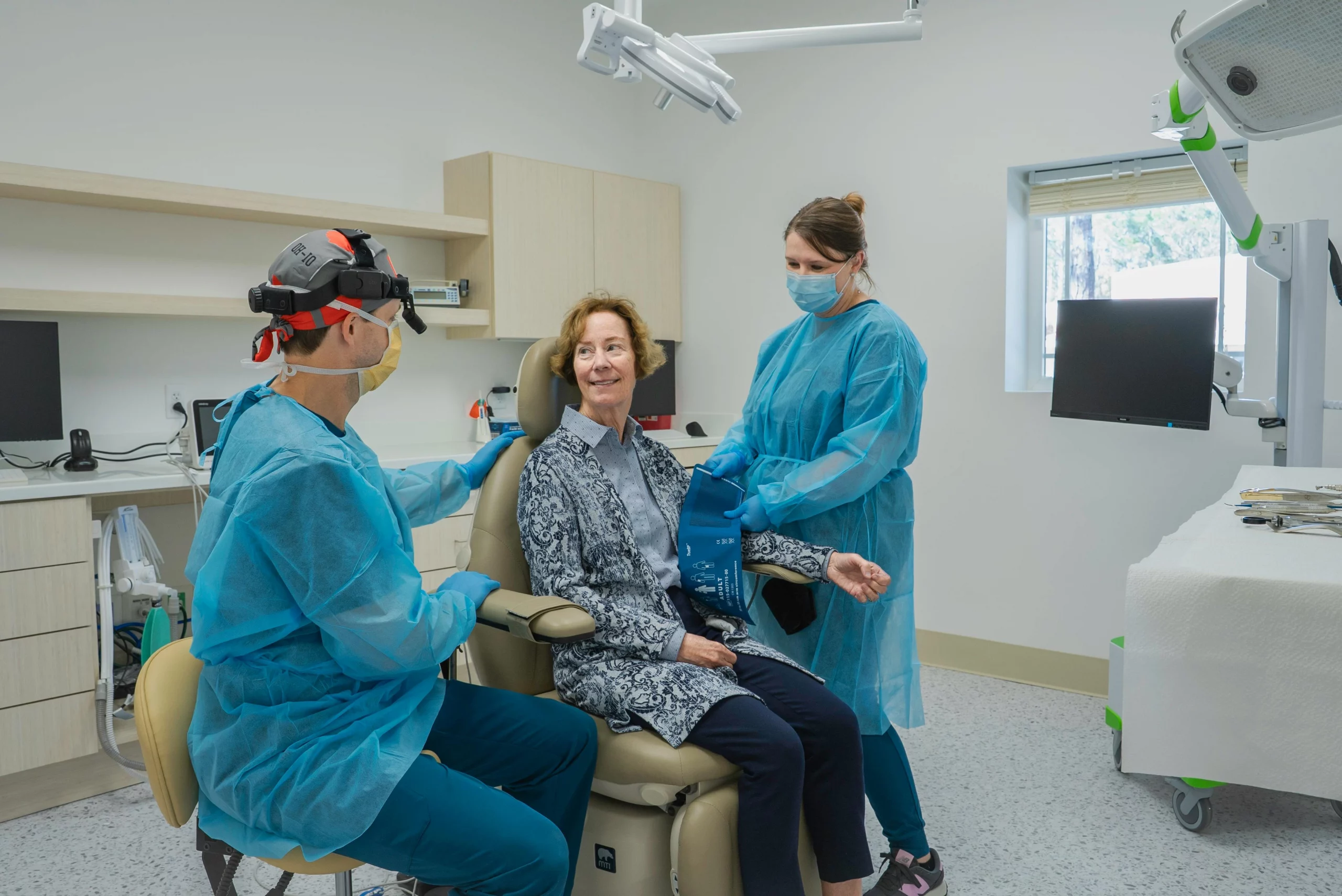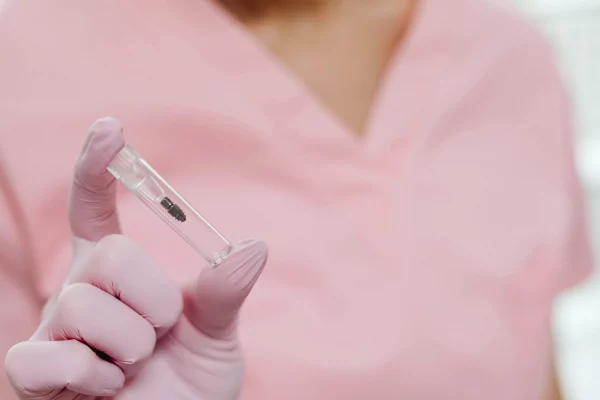If you’re missing the majority or even all of your teeth, All-on-4 dental implants represent a transformative approach that can significantly enhance both oral function and aesthetics. Unlike conventional dentures, this innovative method relies on just four strategically placed implants to anchor a full arch of prosthetic teeth, resulting in a stable and natural-looking restoration.
This overview aims to provide a comprehensive understanding of All-on-4 dental implants: detailing their mechanism, identifying suitable candidates, outlining the procedural steps, discussing recovery expectations, addressing cost considerations, and highlighting the long-term advantages. Equipped with this information, individuals can make well-informed decisions regarding their oral health and self-confidence.
What Are All-on-4 Dental Implants?
All-on-4 dental implants are a revolutionary approach to full-mouth tooth replacement. This method uses just four strategically placed implants to support a fixed, full-arch prosthesis—restoring the function and aesthetics of natural teeth. Unlike traditional dentures that rest on the gums, All-on-4 implants are anchored securely to the jawbone, providing a stable, long-lasting foundation.
This treatment is often life-changing for individuals with severe tooth loss, failing dentition, or those already using removable dentures. It’s designed to restore your confidence, improve oral health, and give you back the freedom to speak, eat, and smile without hesitation.
How the All-on-4 System Works
The All-on-4 technique involves placing two implants vertically at the front of the jaw and two at an angle toward the back. This angling helps avoid the need for bone grafts in many cases, making it a suitable option even for patients with moderate bone loss. After the implants are placed, a temporary prosthetic is attached the same day or within 24 hours allowing you to walk out with a functional smile. Once the jaw has fully healed (usually within 3–6 months), a final, custom-made prosthesis is placed.
Who Is the Ideal Candidate for All-on-4?
The All-on-4 system is particularly well-suited for adults who are missing most or all of their teeth, as well as for those who experience persistent discomfort or instability with traditional dentures. Candidates typically require adequate jawbone density, even in instances of mild bone loss, to support successful implant placement. Good general health is also essential; individuals with uncontrolled chronic conditions may not be suitable due to potential complications with healing and implant integration.
Prior to initiating treatment, dental professionals conduct a comprehensive evaluation, which includes 3D imaging, detailed oral examinations, and a thorough review of both dental and medical histories. This rigorous assessment ensures that the All-on-4 approach aligns with the patient’s specific needs and circumstances.
Differences Between All-on-4 and Traditional Implants
Conventional dental implants typically necessitate the placement of six to eight implants per dental arch. For individuals experiencing considerable bone loss, supplementary bone grafting procedures are frequently indicated. This not only extends the overall duration of treatment but also increases both the financial burden and the invasiveness of the intervention.
Conversely, the All-on-4 technique employs four strategically positioned implants, often mitigating the need for bone grafting. This approach streamlines the procedure, resulting in a reduced healing period and, in many instances, allows for immediate loading, enabling patients to receive a provisional prosthesis on the day of surgery. Collectively, these factors render All-on-4 a more accessible, efficient, and attractive solution for patients pursuing full-arch dental restoration.
Benefits of All-on-4 for Full Mouth Restoration
The All-on-4 system represents a significant advancement for individuals requiring full oral rehabilitation. Notably, one of its primary advantages lies in the immediacy of function; patients frequently depart from the procedure with a complete set of provisional fixed teeth, which promptly restores essential oral functions such as eating, speaking, and smiling. Furthermore, the procedure’s streamlined protocol often negates the necessity for bone grafting, thereby reducing surgical invasiveness and extending treatment accessibility, even to those experiencing some degree of bone loss.
In terms of stability and comfort, All-on-4 dental implants are anchored directly into the jawbone, offering superior support relative to conventional dentures and effectively preventing issues such as slippage or displacement. The system also confers long-term physiological benefits by promoting jawbone stimulation, which helps preserve bone density and mitigates the risk of resorption over time. Aesthetically, All-on-4 provides a natural and attractive smile, which can substantially enhance both appearance and self-confidence. Collectively, these features underscore All-on-4 as a transformative option for patients seeking comprehensive dental restoration.
Fixed and Natural-Looking Solution
All-on-4 prosthetics are custom-designed to match your facial structure and mimic the appearance of natural teeth. Once in place, they feel secure and won’t shift or slip while talking or eating, unlike removable dentures. This permanent, natural-looking smile often restores self-esteem and can dramatically improve social interactions and quality of life.
Faster Recovery and Fewer Surgeries
Since the procedure avoids bone grafting in many cases and uses fewer implants, the healing process is typically shorter and less complicated. Most patients experience minimal downtime and resume light activity within a few days. This streamlined treatment approach also reduces the number of surgical visits, which means fewer disruptions to your schedule.
Long-Term Durability and Functionality
With proper care, All-on-4 implants can last 20 years or more. They’re made of durable materials like titanium (implants) and high-quality acrylic or zirconia (prosthetics), designed to withstand normal chewing forces.
The fixed nature of the prosthesis also promotes better jaw health and minimizes further bone loss—offering structural and functional support that removable dentures can’t provide.
Cost of All-on-4 Dental Implants
The expense associated with All-on-4 dental implants is undeniably significant, typically ranging from $20,000 to $30,000 per arch within the United States. The precise cost fluctuates based on factors such as geographic location, the clinician’s experience, the materials chosen for the prosthetic teeth, and the need for any preparatory procedures (such as extractions).
Notably, this investment generally encompasses the entire course of treatment: initial consultations, diagnostic imaging, tooth removal if indicated, surgical placement of implants, provisional prosthetic teeth, the final restoration, and subsequent follow-up appointments. Many dental practices understand the financial burden involved and therefore provide financing options or payment plans to increase accessibility.
When compared to the cumulative costs associated with traditional dentures—including ongoing repairs, replacements, and the potential for additional health complications—the All-on-4 system frequently demonstrates superior long-term value. In addition to enhanced durability, this treatment tends to improve oral function and overall quality of life for patients.
What’s Included in the Treatment Price?
The All-on-4 procedure encompasses a wide array of services beyond the mere implantation process. Typically, the treatment journey begins with an initial consultation and extends to advanced diagnostics, such as X-rays and 3D imaging, to assess the patient’s oral health comprehensively. Should any teeth require extraction prior to implant placement, this is also included in the preparatory phase.
The surgical phase involves the precise placement of four dental implants, after which a temporary prosthesis is fitted. This provisional set of teeth enables functional use during the healing period, as osseointegration occurs. Once the implants have securely integrated with the jawbone, a custom-fabricated permanent bridge is attached, restoring full function and aesthetics. Routine follow-up care and ongoing monitoring are generally incorporated into the treatment plan to ensure long-term success and early identification of potential complications.
It is crucial for patients to thoroughly review the detailed treatment plan with their provider. This ensures a clear understanding of the services included and helps prevent unforeseen expenses throughout the course of treatment.
Comparing All-on-4 to Other Full Mouth Options
Traditional dental implants tend to be more expensive, particularly when factoring in the need for multiple implants and adjunctive procedures such as bone grafting. In contrast, the All-on-4 approach is generally considered a more cost-effective, comprehensive solution, as it consolidates treatment and often reduces the number of surgical interventions. Although removable dentures may appear less costly initially, they frequently entail ongoing expenses due to necessary adjustments, relines, and eventual replacements. Furthermore, removable dentures typically do not match implants in terms of functionality or aesthetics.
Financing and Insurance Considerations
Many dental practices provide structured payment options or collaborate with healthcare financing institutions to make All-on-4 procedures more accessible. While insurance coverage for the full procedure is uncommon, certain policies may offer partial assistance for services such as tooth extractions, diagnostic imaging, or components of the implant process.
It is advisable to consult directly with your insurance provider regarding potential coverage. Additionally, inquire with your dental office about available financing solutions that align with your financial situation.
What to Expect During the Dental Implants

The All-on-4 procedure involves meticulous preparation prior to the actual surgery day, including comprehensive consultations and imaging. On the scheduled day, any remaining teeth are extracted first. Subsequently, four dental implants are strategically inserted into the jawbone to provide optimal support. Anesthesia—ranging from local to general, depending on individual needs, ensures patient comfort throughout the procedure.
Following implant placement, a provisional set of teeth is immediately affixed, allowing patients to leave with a functional and aesthetically pleasing smile. Over the subsequent months, the implants undergo osseointegration, during which they bond with the surrounding bone tissue. Once this healing phase is complete, a final, custom-fabricated prosthesis is installed, offering durable function, comfort, and natural appearance.
From Consultation to Surgery Day
Undergoing the All-on-4 dental implant procedure typically begins with an in-depth consultation. At this stage, the dental professional collects a comprehensive medical and dental history, often accompanied by advanced imaging techniques, think CT scans or panoramic radiographs—to assess bone structure and overall oral health. Based on this information, a tailored treatment plan is developed to address the patient’s unique needs.
On the day of the procedure, anesthesia or sedation is administered to ensure the patient’s comfort. The clinician strategically inserts four implants into the jawbone, providing a stable foundation. Remarkably, a temporary prosthesis is attached immediately following implant placement, allowing for restored oral function and aesthetics even as the integration and healing process gets underway. This immediate functionality is a significant advantage of the All-on-4 approach, supporting both patient confidence and quality of life during recovery.
Post-Op Recovery and Follow-Up Care
Typically, patients report mild swelling, discomfort, or occasional bruising for several days following the procedure—generally manageable with prescribed medications and a soft-food diet. Stitches either dissolve naturally or are removed by the clinician within one to two weeks. Over the ensuing months, osseointegration occurs as the implants integrate with the jawbone. Once this healing phase is complete, the temporary bridge is replaced by a permanent, custom-fitted prosthesis provided by the dental professional.
Maintaining Your All-on-4 Dental Implants
Long-term success with All-on-4 dental implants really hinges on consistent and thoughtful care. While these prosthetics are engineered for durability, diligent oral hygiene is still non-negotiable. Brushing twice a day with a soft-bristled toothbrush and non-abrasive toothpaste helps maintain both the implants and the health of surrounding gum tissue. It’s also essential to clean those harder-to-reach areas beneath the prosthesis—interdental brushes, floss, or a water flosser can be particularly effective here, disrupting plaque before it can cause problems.
Routine dental checkups and professional cleanings play a critical role as well, enabling early detection and management of any issues that could compromise implant integrity. Patients are strongly advised to avoid behaviors like smoking, chewing on excessively hard objects, or teeth grinding, since these habits can undermine the stability and lifespan of the implants. With conscientious daily care and regular monitoring by a dental professional, All-on-4 implants can provide reliable function and esthetics for many years.
Daily Cleaning and Oral Hygiene Tips
All-on-4 prosthetic implants demand diligent daily maintenance, much like natural dentition. It is advisable to select a soft-bristled toothbrush, combined with a non-abrasive toothpaste, to avoid surface abrasion and preserve the integrity of the prosthetic materials. Additionally, utilizing an alcohol-free, antimicrobial mouthwash supports the reduction of oral bacteria and promotes gingival health.
Equally crucial is the cleaning of the sub-prosthetic area. Employing a water flosser or interdental brushes can facilitate the effective removal of debris and plaque from otherwise inaccessible regions beneath the prosthesis. Adhering to this regimen significantly diminishes the risk of infection or mechanical complications, thereby supporting the long-term functionality and health of the implants.
Regular Dental Checkups and Adjustments
While at-home oral hygiene remains essential, it is equally critical to attend professional cleanings and dental evaluations at least twice per year. These routine visits enable your dentist to assess the condition of your gums and jawbone, ensuring continued implant stability and proper fit of the prosthesis. Minor adjustments may occasionally be warranted as natural wear or shifts in bite occur over time. Regular maintenance appointments allow for the early identification and resolution of potential issues, thereby supporting the long-term function, comfort, and appearance of your All-on-4 restoration.
Frequently Asked Questions (FAQs)
1. How much do All-on-4 dental implants cost?
Prices vary depending on location, materials used, and individual needs, but the cost typically ranges between $15,000–$30,000 per arch. This includes the implants, temporary and permanent prostheses, and related care. Many providers offer flexible financing plans to ease the financial burden.
2. Is the All-on-4 dental implants procedure painful?
The surgery itself is usually pain-free due to local anesthesia or sedation. Post-op discomfort—such as swelling or tenderness—is common but manageable with medication. Most patients describe the experience as more comfortable than expected and are pleasantly surprised by the smooth recovery.
3. How long does the surgery and recovery take?
The surgical procedure takes around 2–4 hours per arch. Most people return to light activity within a few days. Full healing takes 3–6 months, during which the implants integrate with the bone. You’ll wear a temporary prosthesis during this period and receive your final set of teeth once healing is complete.
4. Can All-on-4 dental implants be done on both jaws?
Yes, you can receive All-on-4 implants on both the upper and lower arches. Many patients choose this option to achieve a completely restored smile. Your dentist will assess your jawbone health and overall condition to ensure a safe and successful treatment for both arches.
5. What happens if one dental implant fails?
Though rare, implant failure can occur. Causes include infection, poor bone integration, or excessive force on the implant. If one implant fails, your dentist may replace it or adjust the prosthesis accordingly. Regular checkups and good oral hygiene are your best defense against implant complications.
If you’re struggling with missing teeth or tired of the discomfort of dentures, All-on-4 dental implants could be the solution that transforms your life. Our team is here to guide you every step of the way—from consultation to your final smile.
Schedule your comprehensive implant consultation today to explore your options. Restore your confidence, improve your oral health, and rediscover the joy of a stable, beautiful smile. A lasting solution is just one appointment away.


